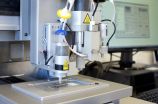Fish offer lessons in effective leadership
2015-06-17
(Press-News.org) Good leaders needing to strike a balance between striving to reach goals and keeping their followers with them has deep evolutionary roots, according to a new study from the Universities of Bristol, Harvard and Princeton on schooling fish.
Dr Christos Ioannou and colleagues devised an experiment to determine the behaviours associated with effective leadership using fish called golden shiners (Notemigonus crysoleucas).
Some of the fish were trained to expect food in a particular dish. These 'informed' individuals were then tested on their ability to reach the dish with a group of eight untrained fish who were uninformed about the target.
Informed fish that exhibited faster and straighter paths (indicative of greater goal-orientation) were more likely to reach their preferred target. However, such behaviour was associated with a tendency to leave the untrained fish behind, therefore failing to transmit their preference to others. Most informed fish were moderately assertive, balancing these two opposing forces.
Dr Ioannou said: "This is the first study showing that such a trade-off exists in animals, matching predictions from computer simulations and what we see in humans. It shows how general this trade-off in leadership is."
Either all or none of the untrained fish stayed with the trained fish in the majority of trials, the researchers found.
"This indicates the importance of interactions between those following a leader," Dr Ioannou continued.
"Leadership thus takes place within a wider network of social interactions."
These mechanistic aspects of effective leadership have important functional consequences for leaders, for example by limiting the speed of decision making when group cohesion is critical. It also shows that getting just a small proportion of followers on board may be enough to
sway the rest.
INFORMATION:
The research, published today in American Naturalist, was partly funded by a Leverhulme Trust Early Career Fellowship.
Paper
'Potential leaders trade off goal-oriented and socially-oriented behavior in mobile animal groups' by Ioannou C.C., Singh M., Couzin I.D. in American Naturalist
ELSE PRESS RELEASES FROM THIS DATE:
2015-06-17
SCOTTSDALE, Ariz. -- An international research team led by Mayo Clinic oncologists has found a new way to identify and possibly stop the progression of many late-stage cancers, including bladder, blood, bone, brain, lung and kidney.
MULTIMEDIA ALERT: Video and audio are available for download on the Mayo Clinic News Network.
The precision medicine study appears online in Oncogene and focuses on kidney cancer and its metastases. Recent studies of the same epigenomic fingerprint in other cancers suggest a common pathway that could help improve the diagnosis and treatment ...
2015-06-17
The best sparkling wines take months to ferment to perfection. In recent years, many winemakers have turned to commercial yeast products to give this process a boost. How they ultimately affect bubbly has been an open question, but now scientists have stepped in to find out. They report their findings in ACS' Journal of Agricultural and Food Chemistry.
When sparkling wine is made, yeast cells burst open in a process called autolysis. This releases a special kind of protein called mannoproteins that, in still wines (the non-bubbly kind), can reduce astringency and bitterness, ...
2015-06-17
Researchers from Cardiff University have pioneered a new technique that will enable scientists to precisely pinpoint the areas on an enzyme that help to speed up chemical reactions.
By labelling certain segments of an enzyme with heavy isotopes, the researchers have found that 'heavy' and 'light' versions of enzymes have different catalytic properties, allowing them to determine which regions are linked to specific functions.
It is hoped this precise pinpointing may shed light on why enzymes are much more efficient at speeding up chemical reactions compared to man-made ...
2015-06-17
LOS ANGELES -- In two ancillary studies of two multi-center international clinical trials led by the University of Southern California (USC) Eye Institute, the injectable drug ocriplasmin appears to improve vision among patients suffering from symptomatic vitreomacular adhesion (VMA), a condition related to the aging eye that could cause permanent vision loss if left untreated.
'These are the first large studies that document patient-reported visual improvement after injection of ocriplasmin for symptomatic VMA,' said Rohit Varma, M.D., M.P.H., director of the USC Eye ...
2015-06-17
Lisbon, 17 June 2015: An IVF technique which freezes all embryos generated in an initial treatment cycle and transfers them in a later cycle as freeze-thawed embryos does not improve outcome as some studies have suggested.
Results of the study, performed at the Instituto Valenciano de Infertilidad (IVI) clinic in Valencia, Spain, are presented today at the ESHRE Annual Meeting by Dr Ernesto Bosch, Medical Director of IVI Valencia, Spain.
As background to his report, Dr Bosch noted that several studies have found improved outcomes in IVF when all embryos are electively ...
2015-06-17
Nyon, Switzerland - June 17, 2015 -- An International Osteoporosis Foundation (IOF) Working Group on Skeletal Rare Diseases has published a new classification of rare genetic metabolic bone disorders (RGMBDs) according to their metabolic pathogenesis.
Skeletal Rare Diseases such as osteogenesis imperfecta, juvenile Paget's disease or osteopetrosis, are only three of the more than 400 developmental abnormalities of the skeletal system that affect patients worldwide. Although rare, these 'orphan' diseases have a very serious, and often devastating, impact on the lives ...
2015-06-17
Scientists at the Ruhr-Universität Bochum established a mouse model for the human disease SCA6. SCA6 is characterised by movement deficits and caused by similar genetic alterations as Chorea Huntington. The mouse model will be used to investigate the disease mechanisms. Experiments suggest that an impairment of eye blink conditioning could be an early disease symptom. The team from the Department of Zoology and Neurobiology published their data in the Journal of Neuroscience; the work was highlighted by the editor's commentary.
Spinocerebellar ataxia 6: structural ...
2015-06-17
This news release is available in German. Ragweed (Ambrosia artemisiifolia) - an otherwise unremarkable plant - produces pollen that can trigger strong allergic reactions such as asthma even in very small quantities. Scientists from Technische Universität München (TUM) and Helmholtz Zentrum München have now published a joint study showing that the substance previously identified as the major allergen only induces such a vigorous allergic response in combination with the adenosine also present in the pollen.
Ragweed only started to become widespread ...
2015-06-17
A group of researchers at Chalmers University of Technology have managed to print and dry three-dimensional objects made entirely by cellulose for the first time with the help of a 3D-bioprinter. They also added carbon nanotubes to create electrically conductive material. The effect is that cellulose and other raw material based on wood will be able to compete with fossil-based plastics and metals in the on-going additive manufacturing revolution, which started with the introduction of the 3D-printer.
3D printing is a form of additive manufacturing that is predicted to ...
2015-06-17
Astronomers have long theorised the existence of a first generation of stars -- known as Population III stars -- that were born out of the primordial material from the Big Bang [1]. All the heavier chemical elements -- such as oxygen, nitrogen, carbon and iron, which are essential to life -- were forged in the bellies of stars. This meansthat the first stars must have formed out of the only elements to exist prior to stars: hydrogen, helium and trace amounts of lithium.
These Population III stars would have been enormous -- several hundred or even a thousand times more ...
LAST 30 PRESS RELEASES:
[Press-News.org] Fish offer lessons in effective leadership

